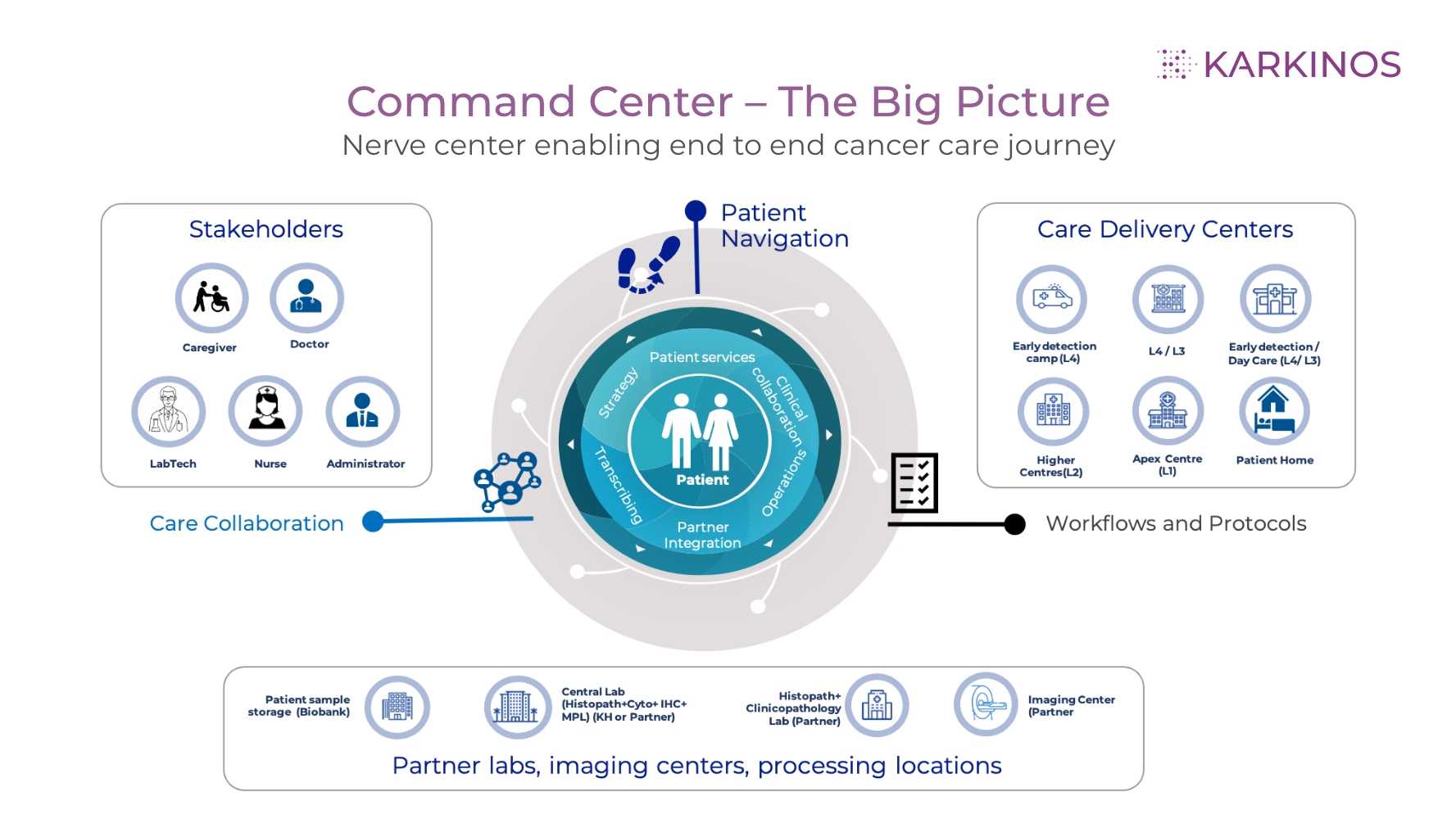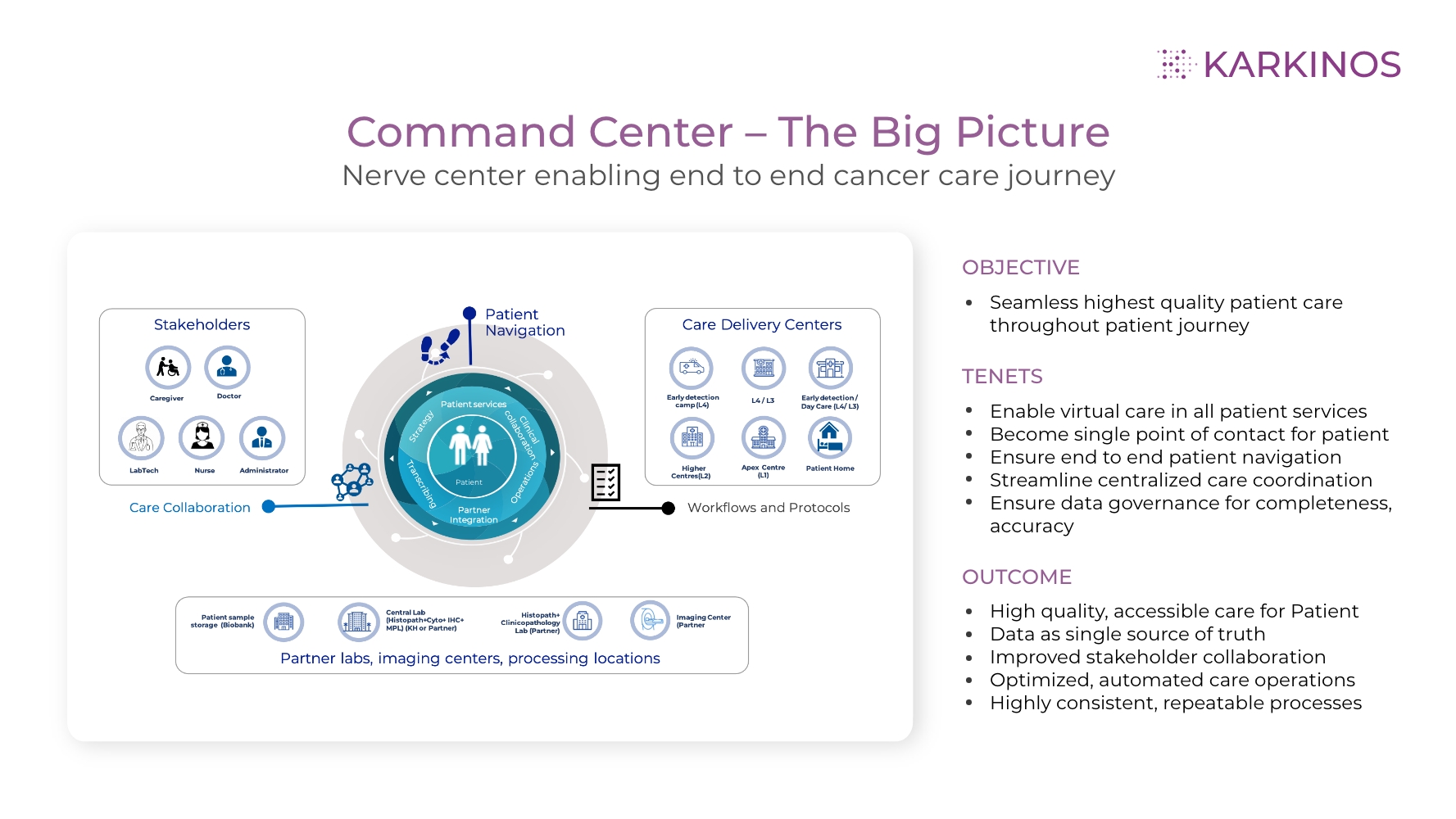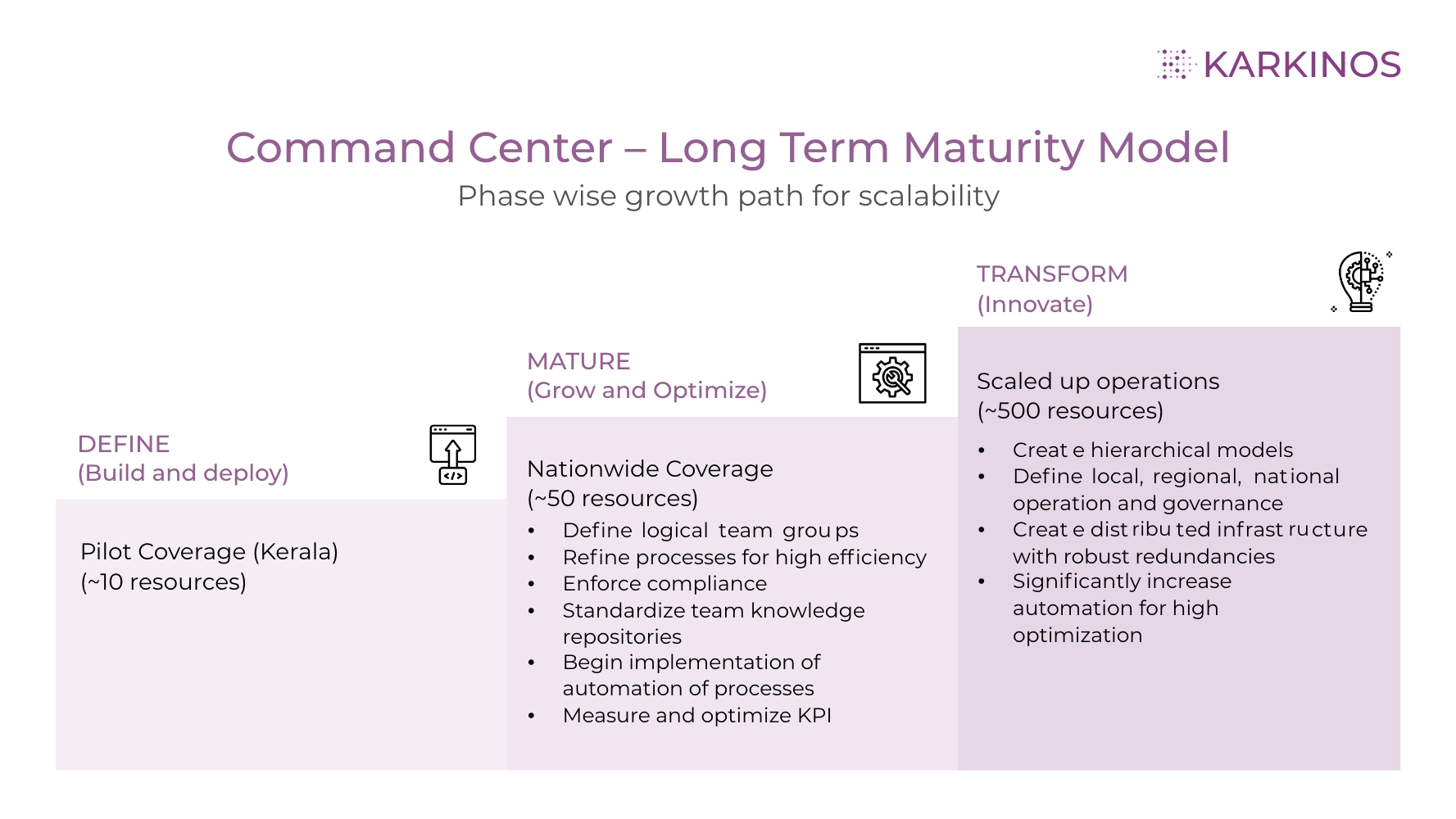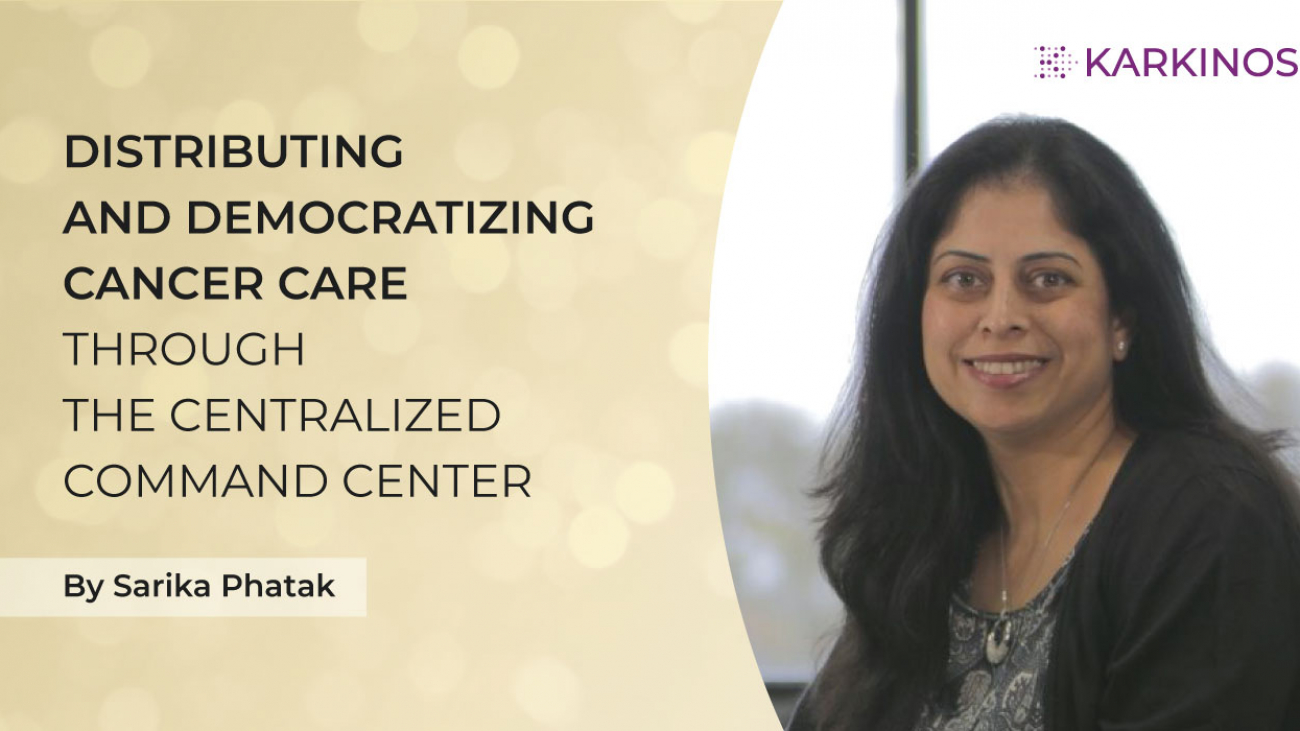The Command Center: Karkinos Healthcare’s war room for distributed and democratized oncology service delivery
By Sarika Phatak, Vice President – Strategic Initiatives, Karkinos Healthcare
Cancer – the complexity of this disease is a no-brainer. It brings immense pain and tormenting agony to the person afflicted with cancer and to the families. The past few decades have seen considerable advances in the way cancer is diagnosed and treated. Yet the growing prevalence of cancer and the looming unequal access to care and the financial incapacities to tackle this disease remain a huge challenge that needs to be addressed at large.
In the face of limited resources not matching the demands of cancer care, the entire medical fraternity is forced to find better ways of allocating those resources to focus on what can make the greatest difference to cancer patients.
Advances in the way we diagnose and treat many forms of cancer have brought about meaningful differences in enhancing the patient’s Quality of Life (QoL) and have transformed outcomes for many patients. Although it may be argued that these advances have addressed the gaps in cancer care, many lacunae are yet to be filled with solutions, especially in making cancer care more affordable and accessible.
Around the world there is agreement that health care is considerably behind other industries in the use of digital technology. It may be even further behind in value improvements that have been seen elsewhere as the result of information technology. To face many such challenges in patient care, a systematic adoption of Healthcare Information Technologies (HIT) is considered a necessity. With the help of IT support management systems, areas like chronic pathologies, home recovery, patient empowerment, coordination of clinical pathways and mixing different disciplines to offer basic care facilities are made possible today. IT adoption allows healthcare professionals to innovate or re-engineer processes and systems to promote economic sustainability of services that would consequently improve quality of care.
As we talk about digitization of healthcare systems, the paper-based records and written patient information and data that persists needed more sophistication, mainly to facilitate evidence-based best practices and functions by all the stakeholders in the healthcare vertical. Maintaining patient information through Electronic Health Records (EHRs) offers wider possibilities to take care closer to the patient. EHRs have helped usher collaborative, multidisciplinary, and cross-organizational healthcare delivery processes thereby democratizing care in a superior manner.
The usefulness of patient data has also become increasingly apparent as a result of the pandemic’s impact. Data analytics-based patient analysis has led to a transformation in the delivery of healthcare and the management of population health. Data analysis, today, underpins any process efficiency efforts and to build clinical decision support systems that have a direct impact on the treatment outcomes. Without these data, it is impossible to identify what works and what does not, or to track any deficiencies in care to their root causes. Healthcare data analytics enables organisations to gain valuable insights from their data, which can be used to identify possibilities to provide more value, efficacy, and higher-quality care at a lower cost.
Likewise, improving the efficiency of cancer care starts with a clear understanding of what outcomes the system is trying to achieve for patients. The entire cancer care pathway appears fragmented currently. With digital technologies being widely adopted, data can be collated and deciphered for meaningful outcomes. Data is also used to drive a culture of continuous improvement with clear accountability mechanisms in place. Increasing efficiency means to deliver what matters most to patients and what will achieve the greatest improvements in their care in a sustainable way. That decision making ability comes through a strong data analytics-powered healthcare platform. Achieving long-term efficiency in cancer care is a complex task, and all stakeholders have a role to play.

Under circumstances where India’s cancer care on the whole is crying out loud for changemakers and digital transformers, the founding team at Karkinos Healthcare took the initiative to launch a cancer care company that has a well-connected digital oncology platform to democratize and distribute cancer care closer to the patient’s home. A war room like Command Center was envisioned, while incepting, as a central disseminator of information and guidance to help every patient navigate across the care pathway seamlessly. It also keeps all treating clinicians and ground staff connected in a system to channelize the workflow.
A war room like Command Center was envisioned as a central disseminator of information and guidance to help every patient navigate across the care pathway seamlessly.
What is a command center and how is Karkinos Healthcare democratizing cancer care through it?
With the wider development, adoption and deployment of healthcare information technology and digital applications in recent years, command centers have been established as a permanent operational model to manage the complex daily processes of a health system.
For Karkinos Healthcare to deliver cancer care through its hub-and-spoke model, the leadership team was determined to set up the Command Center. We were clear from the start that a systematic process should be in place to ensure that a patient should never get dropped from the care pathway. We believe that the company should not turn a cancer patient away without addressing the problem. The purpose of the command center is to keep the processes seamless for the patient and tend to the patient at all levels of care using all forms of care delivery (via in-person or through digital means).
So, our command center has been developed with an aim to improve patient outcomes through a centralized quality control and coordination of care mechanism. A coordinated and modular approach enables us to implement shared decision-making and comprehensive care for patients by the interdisciplinary experts on board. This center ensures that the information flow at all levels of care is done in an efficient manner for every single patient. This way, good orchestration practices between departments are enforced and a well-connected ecosystem of care is created for the benefit of the patient. Likewise, the center enables the care team treating the patient to stay connected easily at every patient touch point.
While a process mechanism is in place, the command center becomes responsible for generating, recording, and analyzing patient data, which is very important to customize treatment plans for the patient. To optimize decision making, the command center works to gather data, evaluate and verify it, analyze and categorize data and to finally develop Artificial Intelligence-based solutions to automate the process, wherever necessary. All these actions enable the healthcare personnel on ground to make informed decisions and bring quality of care closer to patients.
Karkinos Healthcare, while designing this command center, had also borne in mind the need for a flexible system. When I refer to flexibility, I mean that the command center is designed to be completely virtual, digital, and paperless everywhere possible yet be onsite/in-person wherever required. There should absolutely be no restrictions in its scope of servicing the patient. Such a center will help us target our goals of developing an ace clinical workflow system and also to offer better clinical outcomes. The center also allows us to achieve our core vision of offering patient-centric cancer care closer to the patient’s home.

The other significant feature of this command center is the ability to keep the service architecture at a central hub and extend out to not only patients but to all of Karkinos Healthcare’s partner hospitals and service providers (as spokes). As Karkinos Healthcare believes in leveraging existing service providers’ expertise, having them connected to the command center allows us to deliver distributed care that invariably addresses accessibility of care to patients who live in locations distant from the tertiary care centers.
The other major factor that a command center supports is to fulfill Karkinos Healthcare’s primary objective to widen the cancer screening programs across the stretch of the country covering as many remote locations as possible. It is proven that early detection of cancer has several advantages. Hence, it is in the DNA of Karkinos Healthcare’s command center to help screening programs reach populations at highest risk of cancer, enable early diagnosis, and improve treatment outcomes in a cost-effective manner. The command center also lays thrust on providing follow-up care and palliative care wherever necessary.
Command centers also have the capabilities to harness data from digital health applications for greater patient engagement. The ubiquitous use of mobile phones and messenger applications help us to meet the requirements of the care continuum. Overlaying interactive applications on our interfaces have offered us tremendous scope to connect with the patients in several ways and also enable real-time monitoring of the patient (be it at home through remote care or at a hospital). Data, however, is recorded, processed, and appropriate action is taken by the command center. In simple words, by leveraging data analytics and by centralizing the workflow at the command center, Karkinos Healthcare is simply re-engineering the processes in cancer care to screen, detect, and reduce the incidence of cancer cases in India and beyond.
It is in the DNA of Karkinos Healthcare’s command center to help screening programs reach populations at highest risk of cancer, enable early diagnosis, and improve treatment outcomes in a cost-effective manner.
Cancer care out of a box
We know, across the world, several disparities remain in the approaches of cancer care. Many people in low resource settings have no access to basic wellness screening, early detection, or diagnosis. The world has awakened to the fact that treating cancer can no longer be prescriptive but has to be proactive and preventive, which can be enabled by specialized Point of Care devices and technologies, wearables, and home monitoring devices for cancer care.
In today’s cancer treatment, Point of Care (PoC) devices and technologies are playing critical roles in both high- and low-resource settings, and their success is transforming cancer care like never before. The versatility, cost-effectiveness, and simplicity of PoC devices or technologies have a significant potential to revolutionize cancer detection, diagnosis, and treatment.
PoC imaging devices and diagnostic tests for the detection and diagnosis of cancer are evolving and that has parallelly allowed the development of resource-appropriate treatment options for patients. Technically, cancer care out of a box refers to the easy portability of screening and diagnostic equipment that can be taken to the patient’s location that may even be extremely remote. The advent of plug-and-play devices in cancer diagnosis has brought about never seen advantages and Karkinos Healthcare is definitely making the best of those advantages.
With the help of internet connection, the patient/citizen data that is recorded from these devices are received at the command center and data analytics provides insights on the way forward in handling the patient right from screening, early diagnosis to treatment.
The platform is designed to be a WIN-WIN model for everybody, be it for our citizens, patients or for our partners. The multi-disciplinary teams have a common goal – to make cancer care affordable and accessible.
A sustained pursuit
Karkinos Healthcare’s vision is bold, re-defining, and purpose-led in cancer care. Our participative and distributive digital oncology platform will leave no stone unturned in cancer care. The platform is designed to be a WIN-WIN model for everybody, be it for our citizens, patients or for our partners. The multi-disciplinary teams have a common goal – to make cancer care affordable and accessible. It is a long journey that the company has set out on and along its way, sustainable solutions that can re-engineer cancer care for betterment of the society will remain.

The pursuit is to establish a dynamic oncology platform that is scalable to benefit the end user. The construct of the platform is designed to bring a shift in the thinking of a common man to prioritize preventive care over prescriptive care and also from illness to wellness.
